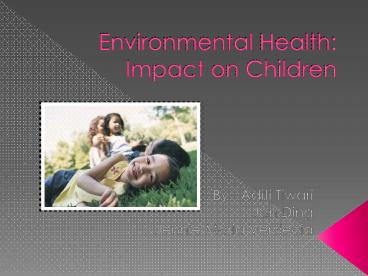Environmental Health: Impact on Children - PowerPoint PPT Presentation
1 / 24
Title:
Environmental Health: Impact on Children
Description:
http://www.youtube.com/watch?v=2e75_sYvOOU They are more susceptible to toxins due to: 1) Take in more food, water, and air 2) Carcinogens relative to body weight 3 ... – PowerPoint PPT presentation
Number of Views:76
Avg rating:3.0/5.0
Title: Environmental Health: Impact on Children
1
Environmental Health Impact on Children
- By Aditi Tiwari
- Jan Ding
- Jennie Maria Verdecia
2
Climate change and children
- http//www.youtube.com/watch?v2e75_sYvOOU
3
Children are more at risk
Why?
- They are more susceptible to toxins due to
- 1) Take in more food, water, and air
- 2) Carcinogens relative to body weight
- 3) Infants higher exposure of substances
- i.e. through breast milk
- 4) Higher dose of toxins, greater gene
- damage
4
- 5) Less efficient detoxification and repair
- systems
- 6) Higher rate of cell proliferation in
- developmental stages
- 7) Increased absorption and retention
5
Office of Childrens Health Protection (OCHP)
- Established May 1997 in U.S.
- Goal Protect childrens health from
environmental threats - Since fall of 1996, the EPA has followed a
seven-step National Agency to Protect Childrens
Health from Environmental Threats
6
National Agenda Instructs Agency to
- 1) Ensure all standards set by EPA are protective
of heightened risks faced by children - 2) Develop scientific research strategies to
focus on gaps in knowledge for child-specific
susceptibility and exposure - 3) Develop new, comprehensive policies to address
cumulative and simultaneous exposures faced
7
Seven-step agenda continued
- 4) Expand community rights-to-know, allowing
families to make informed choices - 5) Encourage parental responsibility for
protecting children from threats by providing
with basic info - 6) Encourage and expand educational efforts with
health care providers and environmental
professionals - 7)Provide necessary funding to address childrens
health as top priority among relative health risks
8
Diagram showing how children are exposed
9
Global Facts
- About 18 of worlds people do not have access to
safe drinking water - In large cities of developing countries, the
percentage of un-accounted for water is 40 - Diarrheal diseases claim nearly 2 million
childrens lives each year - Air pollution is at a crisis point in many major
cities with over one billion urban residents who
breathe unhealthy air - Climate change is altering weather patterns and
disturbing life-supporting natural systems and
processes - Unsustainable management of chemicals and
hazardous wastes is exacting a heavy toll on
human health
10
Traditional environmental threats to
health
- Contaminated water
- Poor sanitation
- Indoor smoke pollution
- Disease vectors via mosquitoes
- Deficient food hygiene
- Unsafe waste disposal
- These are usually associated with poverty and
social exclusion
11
More modern environmental
health hazards
- Air, water, soil pollution
- Unsafe use of chemicals-or chemical dumping
- Inadequate solid and hazardous waste management
- Climate change
- Ozone layer depletion and acid rain due to fossil
fuels
12
Top killers for children under 5
Source United Nations Childrens Fund (UNICEF),
Progress since the World Summit for Children A
Statistical Review, page 3, UNICEF, New York,
September 2001.
13
Asthma
- Is an inflammation of the air passages.
- Is a major public health concern.Health
officials estimate that over six million children
suffer from asthma. - Asthma continues to impact children, from 1980 to
1996 its prevalence has increased by an average
of 4.3 per year, from 3.6 to 6.2. - Usually affecting inner city children.
- Though there is no cure there are preventive
measures.
14
Environmental Factors
- Outdoor air pollution can worsen existing asthma.
- Outdoor pollutants known to trigger asthma
attacks include ozone, particulate matter,
nitrogen dioxide, and sulfur dioxide. - Roaches and Rodents.
- Damp indoor spaces.
15
Neurodevelopment Disorders
- Such as ADHD, (attention deficit disorders.)
- Chemicals such as lead, mercury, and pesticides
can lead to neurodevelopment disorders, such as
ADHD. - Lead and prenatal tobacco smoke exposure as
precursors of ADHD in children.
16
ADHD
- There isnt any preventive treatment as of yet
for ADHD. - During pregnancy women can avoid alcohol, drugs,
and smoking and that alone can help prevent a
child from developing behavior similar to ADHD as
well as many other health problems.
17
Again, who are effected?
Source http//www.mailonsunday.co.uk/home/mosliv
e/article-1033832/The-Dirty-Secret-Your-NHS.html
18
e-wasteland in Lagos
Source http//www.pubmedcentral.nih.gov/articlere
nder.fcgi?artid1440802
19
Things to remember..
- Worldwide, 13 million deaths could be prevented
every year by making our environments healthier. - In children under the age of five, one third of
all disease is caused by the environmental
factors such as unsafe water and air pollution. - A childs well-being is highly dependent on both
the quality and the availability of water. - Children are among the most vulnerable to the
health aspects of crises.
20
Things to remember
- Better environmental management could prevent 40
of deaths from malaria, 41 of deaths from lower
respiratory infections, and 94 of deaths from
diarrhoeal disease three of the world's biggest
childhood killers. - In developed countries, healthier environments
could significantly reduce the incidence of
cancers, cardiovascular diseases, asthma, lower
respiratory infections and musculoskeletal
diseases.
21
Things we can do..
- Help children breathe easier
- Protect children from lead poisoning
- Keep pesticides and other toxic chemicals away
from children - Protect children from carbon monoxide (CO)
poisoning - Protect children from contaminated fish and
polluted water
22
Things we can do..
- Safeguard children from high levels of radon
- Protect children from too much sun
- Keep children and mercury apart
- Promote healthier communities
23
References
- WHO - Childs Health http//www.who.it/childheal
thenv - http//who.int/features/factfiles/environmental_he
alth/environmental_health_facts/en/index9.html - Children in the New Millennium
- http//www.unep.org/ceh/main01.html
- http//yosemite.epa.gov/ochp/ochpweb.nsf/content/t
ips.htm
24
Any questions? Thank you!!































